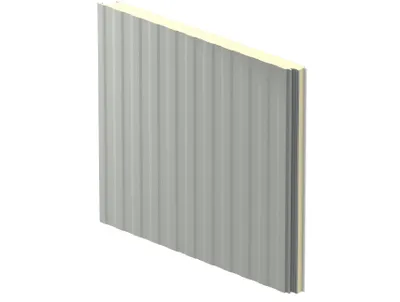


Metl-Span’s CF Mesa insulated metal panels are the complete package when it comes to building envelope solutions. The low-profile corrugated panel with 1/8″ ribs not only provides thermal, vapor and moisture barriers in a single component, but also offers high R-values to create an energy-efficient environment too. The Mesa profile is designed with concealed clips to reduce thermal bridging and is well equipped for applications on exterior walls, interior walls and ceilings. You can choose between an embossed or non-embossed profile with a galvanized or aluminum-zinc-coated steel face.
Similar to our CF Light Mesa panels, our CF Mesa insulated metal panels are used for commercial, institutional and industrial buildings. By incorporating sustainability factors into their design, the Mesa profile adheres to green building standards where energy efficiency is paramount.
Mesa panels are also ideal for cold storage applications, including dry goods warehouses, refrigerated and freezer buildings, food processing facilities and all temperature-controlled environments. Contact our representatives today to find out more!
30″*, 36″, 42″, 44″ **
PIR
NON DIRECTIONAL GRAFIED
8′-0″ to 52′-0″ Vertical
NOT GAUGED
8′-0″ to 40′-0″ Vertical
PUR
NON DIRECTIONAL GRAIN
8′-0″ to 32′-0″ Horizontal
8′- 0″ to 52′-0″ Vertical
UNGRAVED
8′-0″ to 16′-0″ Horizontal
8′-0″ to 40′-0″ Vertical
G-90 galvanized steel or AZ-50 aluminum-zinc coating in 26, 24 or 22 Ga.
Fluropon, Fluropon Premier, Fluropon Classic, Flurothane, Flurothane Coastal, WeatherXL, Igloo White Polyester
U-factor (BTU/h-ft2*fahrenheit)
Panel width: 42″ at 35 degrees
2″ = 0.058
2.5″ = 0.045
3″ = 0.038
4″ = 0.028
5″ = 0.022
6″ = 0.019
8″ = 0.014
R- Value (h*ft2*F/BTU)
Panel width: 42″ to 35 degrees
2″ = 17.9
2.5″ = 22.4
3″ = 26.9
4″ = 35.9
5″ = 44.8
6″ = 53.8
8″ = 71.7
Thermal values, including R-value and U-value, are crucial metrics used in building construction and insulation to quantify the ability of materials to resist heat transfer. Here’s what each means:
1. ** R** value:
– The R-value measures a material’s thermal resistance, indicating its ability to resist heat flow. The higher the R value, the better the insulation.
– It’s a measure of thermal resistance per unit area. So the thicker the insulation (or the higher its thermal resistance), the higher the R-value.
– The R-value is commonly used in the USA and some other countries to specify insulation performance for various building components such as walls, roofs and floors.
– Higher R-values are desirable in colder climates to minimize heat loss in buildings during winter.
2. ** U coefficient**:
– The U-value is the thermal transmittance of a material, indicating the rate of heat transfer through it. The lower the U-value, the better the insulation.
– Unlike the R-value, which measures resistance, the U-value measures the amount of heat that can pass through a material.
– This is the reciprocal of the R-value. So a material with a high R-value will have a low U-value.
– The U-value is commonly used in Europe and other parts of the world to quantify the insulating properties of windows, doors and other building components.
– Lower U coefficients are desirable in hot and cold climates to reduce the amount of heat transferred through building components, thus improving energy efficiency.
In summary, R-value and U-value are complementary metrics used to assess the insulating properties of materials. While the R-value measures thermal resistance, indicating a material’s ability to prevent heat flow, the U-value measures thermal transmittance, indicating the amount of heat that can pass through a material. Both are essential for designing energy-efficient buildings and choosing appropriate insulation materials.
Customized solutions to meet your needs and expectations